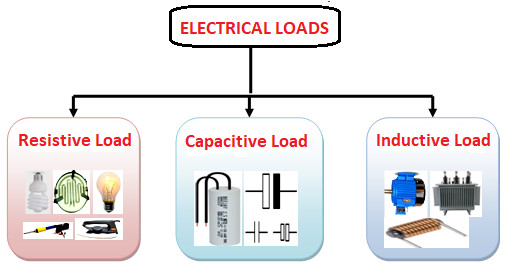
A load is a machine or device that receives electrical energy. In other words, all the machines or devices that receive electrical energy and convert that energy into different energies (light, heat, sound, motion etc.) are called electrical or electrical loads. For example: We get light in our house with the help of electric lamp, in this case electricity is converted into light energy. At the same time the electric motor is converting electrical energy into mechanical energy.
Classification of Electrical Loads:-

Power Factor:- Power factor is usually referred to as CosØ, which value is between .8 and .9
Resistive load: Resistive load means electric lamp, electric iron, soldering iron and electric heater etc., these are all examples of resistive load. All of them convert electrical energy into heat and light energy. Power factor of resistive loads is 1 or unity.

Power, P= VICosØ
Power, P= VI [CosØ=1]
Capacitive Load: Capacitive load refers to non-polarized (1.5 to 3.5 microfarads) capacitors. In circuits using capacitors, the current is 900 ahead of the voltage. Capacitor loads have power factor values of .8 or .9.

Power, P= VICosØ
Power, P= VI X.9 [CosØ=.9]
Inductive load: Inductive load refers to the loads or machines that are made by twisting copper wires of different gauges. In circuits using inductor loads, the voltage is 900 leading from the current. Inductive loads have power factor values of .8 or .9 lagging.

Power, P= VICosØ
Power, P=VIX.৪ [ CosØ=.8]
Power system load:- Power system load includes household load, industrial load, commercial load and agricultural load.
The classification is shown in below:-

Household loads are called domestic loads, industrial loads are called industrial loads, commercial loads are called commercial loads and agricultural loads are called agricultural loads.
